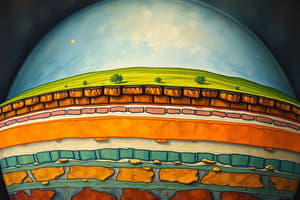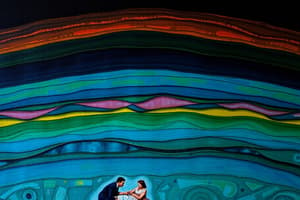Podcast
Questions and Answers
If a scientist discovers a new rock sample with a density of 3.1 g/cm³, in which layer of Earth is this rock most likely located?
If a scientist discovers a new rock sample with a density of 3.1 g/cm³, in which layer of Earth is this rock most likely located?
- Outer core
- Continental crust
- Oceanic crust
- Upper mantle (correct)
Which statement best describes the primary difference between the Earth's inner and outer core?
Which statement best describes the primary difference between the Earth's inner and outer core?
- The inner core has a lower density than the outer core.
- The inner core is composed of silicate minerals, while the outer core is composed of iron and nickel.
- The inner core is primarily basalt, while the outer core is primarily granite.
- The inner core is solid due to immense pressure, while the outer core is liquid. (correct)
How might the composition of the Earth's crust differ in a region with significant tectonic activity compared to a stable continental area?
How might the composition of the Earth's crust differ in a region with significant tectonic activity compared to a stable continental area?
- Stable continental areas have more basalt due to less volcanic activity.
- Regions with tectonic activity may exhibit greater variability in crustal composition due to plate interactions. (correct)
- There would be no significant difference in crustal composition between the two regions.
- Regions with tectonic activity would likely have a crust composed mainly of granite.
If seismic data indicates a region with a crustal thickness of 60 km, what type of crust is most likely present?
If seismic data indicates a region with a crustal thickness of 60 km, what type of crust is most likely present?
How would an increase in the proportion of magnesium (Mg) relative to iron (Fe) in the mantle likely affect its overall density?
How would an increase in the proportion of magnesium (Mg) relative to iron (Fe) in the mantle likely affect its overall density?
Flashcards
Crust
Crust
The uppermost layer of the Earth, composed of granite (continental) and basalt (oceanic).
Mantle
Mantle
The layer beneath the crust, consisting of silicate minerals and making up 83% of Earth's volume.
Outer Core
Outer Core
The liquid layer of the Earth's core, primarily made of iron and nickel, about 2900 km thick.
Inner Core
Inner Core
Signup and view all the flashcards
Granite
Granite
Signup and view all the flashcards
Study Notes
Earth's Layers
- Earth's interior is composed of three main layers: crust, mantle, and core.
- The crust is the outermost layer, ranging from 5 km to 70 km thick on the ocean floor to 30 km on the continents.
- The mantle is located beneath the crust, extending to a depth of approximately 2900 km. It's about 83% of Earth's volume and 67% of its mass.
- The core is the innermost layer, divided into the outer core (liquid) and inner core (solid). The outer core's depth is about 2900 km to 5150 km. The inner core's depth is about 5150 km to 6370 km.
Recent Views on Layers
- The crust is divided into oceanic and continental types; ocean crust is thinner and denser than continental.
- The upper mantle is considered the asthenosphere, a zone of weak, partially molten rock.
- The lower mantle is composed of solid rock.
- The outer core is liquid iron and nickel, resulting in convection currents that generate Earth's magnetic field.
- The inner core is solid iron and nickel, under immense pressure.
Composition of Earth's Layers
- The crust is primarily composed of silicate rocks (e.g., granite and basalt).
- The mantle is primarily composed of silicate minerals, with magnesium and iron being prevalent elements.
- The core is mainly made of iron and nickel.
Density of Layers
- Crust: 2.7-3.0 g/cm³
- Upper Mantle: 3.3-5.5 g/cm³
- Lower Mantle: 5.5-6.0 g/cm³
- Outer Core: 9.9-12.2 g/cm³
- Inner Core: 12.8 g/cm³
Importance of Layers
- The layers vary in composition, temperature, and density. These variations drive various geological processes, like plate tectonics and volcanism.
- Differences in density and heat drive convective currents within the mantle, which contribute to plate movement.
- Convection currents in the outer core are responsible for creating Earth's magnetic field.
Rock Types
- Rocks are classified as igneous, sedimentary, or metamorphic based on their formation.
- Igneous rocks form from the cooling and solidification of magma (molten rock).
- Sedimentary rocks are formed from the accumulation and cementation of sediments.
- Metamorphic rocks are formed from the alteration of existing rocks through heat and pressure.
Elements in Rocks
- Important elements include silicon, oxygen, magnesium, iron, calcium, sodium, potassium, and aluminum.
- Silicates are the most abundant minerals in the Earth's crust.
Studying That Suits You
Use AI to generate personalized quizzes and flashcards to suit your learning preferences.




